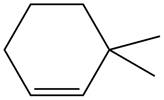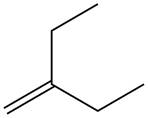
Concept explainers
Draw all constitutional isomers formed when each
a. b.
b. c.
c. 
(a)
Interpretation: The constitutional isomer formed by the reaction of given alkene with
Concept introduction: The reaction of alkene with
Answer to Problem 15.18P
The constitutional isomers formed by the reaction of given alkene with

Explanation of Solution
The reaction of alkene with
The given alkene is shown below.

Figure 1
The general steps involved in the reaction of allylic bromination with
• The first step is the initiation of bromine radical.
• The next step is the propagation in which generation of allylic radical take place.
• In third step, allylic radical reacts with
The constitutional isomer formed by the reaction of given alkene with

Figure 2
Therefore, the constitutional isomers formed for the given reaction are
The constitutional isomers formed by the reaction of given alkene with
(b)
Interpretation: The constitutional isomer formed by the reaction of given alkene with
Concept introduction: The reaction of alkene with
Answer to Problem 15.18P
The constitutional isomers formed by the reaction of given alkene with

Explanation of Solution
The reaction of alkene with
The given alkene is shown below.

Figure 3
The general steps involved in the reaction of allylic bromination with
• The first step is the initiation of bromine radical.
• The next step is the propagation in which generation of allylic radical take place.
• In third step, allylic radical reacts with
The constitutional isomer formed by the reaction of given alkene with

Figure 4
Therefore, the constitutional isomers formed for the given reaction are
The constitutional isomers formed by the reaction of given alkene with
(c)
Interpretation: The constitutional isomer formed by the reaction of given alkene with
Concept introduction: The reaction of alkene with
Answer to Problem 15.18P
The constitutional isomers formed by the reaction of given alkene with

Explanation of Solution
The reaction of alkene with
The given alkene is shown below.

Figure 5
The general steps involved in the reaction of allylic bromination with
• The first step is the initiation of bromine radical.
• The next step is the propagation in which generation of allylic radical take place.
• In third step, allylic radical reacts with
The constitutional isomer formed by the reaction of given alkene with

Figure 6
Therefore, the constitutional isomers formed for the given reaction are
The constitutional isomers formed by the reaction of given alkene with
Want to see more full solutions like this?
Chapter 15 Solutions
Organic Chemistry
- :0: :0: Select to Add Arrows :0: (CH3)2NH :0: ■ Select to Add Arrows :0: :0: (CH3)2NH ■ Select to Add Arrowsarrow_forwardDraw the product of the following H action sequence. Ignore any inorganic byproducts formed. 1. (CH3CH2)2CuLi, THF 2. CH3Br Q Atoms, Bonds and Rings H Charges ㅁarrow_forwardPlease help me with this the problem is so confusingarrow_forward
- 14 Question (1 point) Disiamylborane adds to a triple bond to give an alkenylborane. Upon oxidation with OH, H2O2, the alkenylborane will form an enol that tautomerizes to an aldehyde. In the first box below, draw the mechanism arrows for the reaction of disiamylborane with the alkyne, and in the last box draw the structure of the aldehyde. 4th attempt Feedback i > 3rd attempt OH, H2O2 i See Periodic Table See Hintarrow_forwardanswer with mechanisms and steps. handwritten please!arrow_forwardHello I need some help with Smartwork. For drawing structure B, I know the correct answer is CH₃B₂, but when I try to type it in, it keeps giving me CH₄BH₃ instead. Do you know how I should write it properly? Should I use a bond or something else?arrow_forward
 ChemistryChemistryISBN:9781305957404Author:Steven S. Zumdahl, Susan A. Zumdahl, Donald J. DeCostePublisher:Cengage Learning
ChemistryChemistryISBN:9781305957404Author:Steven S. Zumdahl, Susan A. Zumdahl, Donald J. DeCostePublisher:Cengage Learning ChemistryChemistryISBN:9781259911156Author:Raymond Chang Dr., Jason Overby ProfessorPublisher:McGraw-Hill Education
ChemistryChemistryISBN:9781259911156Author:Raymond Chang Dr., Jason Overby ProfessorPublisher:McGraw-Hill Education Principles of Instrumental AnalysisChemistryISBN:9781305577213Author:Douglas A. Skoog, F. James Holler, Stanley R. CrouchPublisher:Cengage Learning
Principles of Instrumental AnalysisChemistryISBN:9781305577213Author:Douglas A. Skoog, F. James Holler, Stanley R. CrouchPublisher:Cengage Learning Organic ChemistryChemistryISBN:9780078021558Author:Janice Gorzynski Smith Dr.Publisher:McGraw-Hill Education
Organic ChemistryChemistryISBN:9780078021558Author:Janice Gorzynski Smith Dr.Publisher:McGraw-Hill Education Chemistry: Principles and ReactionsChemistryISBN:9781305079373Author:William L. Masterton, Cecile N. HurleyPublisher:Cengage Learning
Chemistry: Principles and ReactionsChemistryISBN:9781305079373Author:William L. Masterton, Cecile N. HurleyPublisher:Cengage Learning Elementary Principles of Chemical Processes, Bind...ChemistryISBN:9781118431221Author:Richard M. Felder, Ronald W. Rousseau, Lisa G. BullardPublisher:WILEY
Elementary Principles of Chemical Processes, Bind...ChemistryISBN:9781118431221Author:Richard M. Felder, Ronald W. Rousseau, Lisa G. BullardPublisher:WILEY





